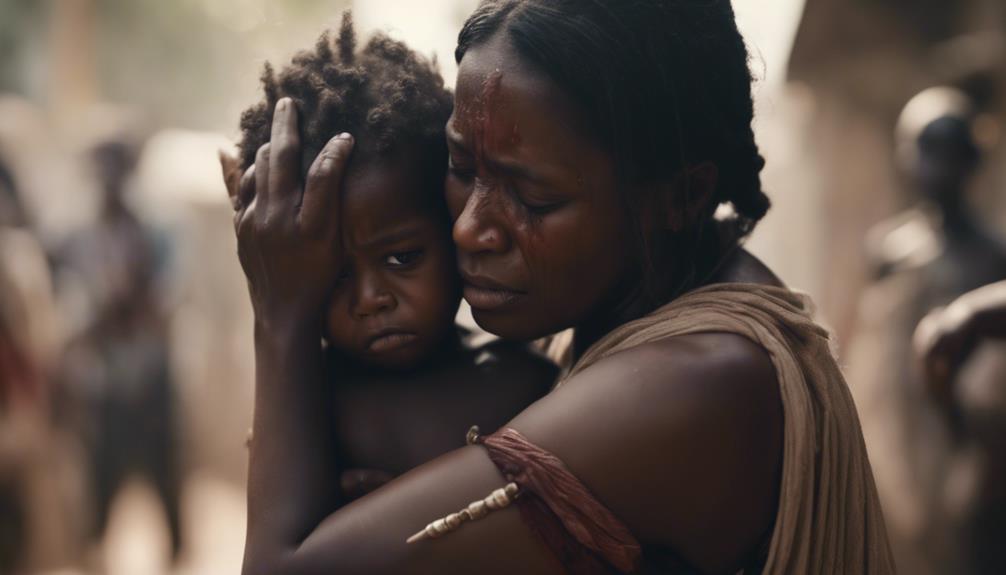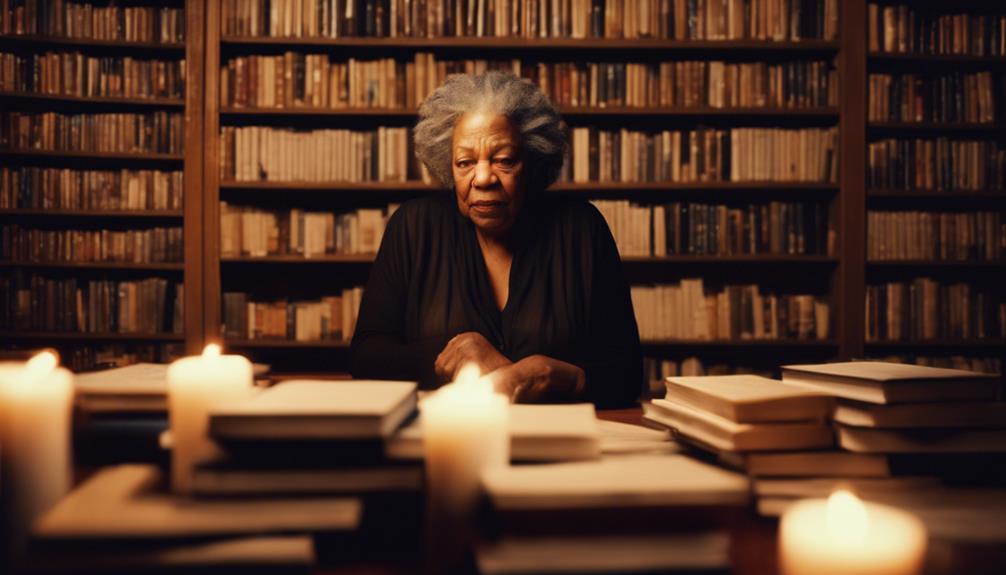Uncover the tragic backstory of the beloved character, 'Beloved,' through the harrowing real-life inspiration drawn from Margaret Garner's 1856 escape and Sethe's poignant maternal sacrifice. Discover the profound maternal love that transcended oppression and the unfathomable choices enslaved individuals faced to protect their children. Examine the enduring impact of slavery's atrocities on generations, as Toni Morrison's narrative power weaves a tale of trauma, sacrifice, and resilience. The haunting parallels between Sethe's narrative and Margaret Garner's tragedy illuminate the depths of maternal love and the agonizing choices confronted by enslaved mothers. Explore the intricate layers behind this beloved character for deeper insights.
Key Takeaways
- Margaret Garner's tragic escape in 1856 mirrors Sethe's harrowing path in 'Beloved'.
- Sethe's character is inspired by Margaret Garner's maternal sacrifice.
- The impact of historical tragedies on maternal relationships is evident in 'Beloved'.
- Enslaved individuals, like Sethe, endured unimaginable sacrifices for their children.
- Toni Morrison's exploration of trauma and sacrifice in 'Beloved' reflects real-life harrowing experiences.
Margaret Garner's Tragic Escape
During her escape from slavery in 1856, Margaret Garner made a heart-wrenching decision that would haunt her forever. Fearing the return to bondage of her children, Garner chose to take the life of her own daughter rather than see her suffer the horrors of slavery.
This tragic event, deeply rooted in desperation and maternal sacrifice, inspired Toni Morrison's renowned novel 'Beloved,' where the character Sethe grapples with a similar harrowing choice. Garner's escape unfolded in Cincinnati, Ohio, where the family sought freedom but instead found themselves embroiled in a legal battle after the fatal incident.
The gut-wrenching decision made by Garner sheds light on the unimaginable struggles faced by enslaved individuals in their pursuit of liberation. The echoes of her heartbreaking choice resonate through history, immortalized in Morrison's work, serving as a poignant reminder of the brutal realities endured by those seeking freedom from the chains of slavery.
Maternal Sacrifice to Avoid Slavery

Margaret Garner's heartbreaking decision to sacrifice her own child rather than see her return to the horrors of slavery is a testament to a mother's selfless love and determination to protect her family at all costs.
This act of unimaginable sacrifice highlights the lengths to which individuals were willing to go to escape the brutalities of slavery and uphold their humanity in the face of oppression.
The haunting legacy of maternal sacrifice in the narrative of 'Beloved' serves as a powerful reminder of the enduring strength of love even in the most dire circumstances.
Mother's Selfless Choice
The selfless act of maternal sacrifice to avoid slavery profoundly impacted both Margaret Garner and Sethe in their respective journeys. This heartbreaking decision, made out of love and desperation, showcases the unimaginable challenges faced by enslaved mothers.
Here are three key aspects of this mother's selfless choice:
- Protection from Inhumane Bondage: Margaret Garner's ultimate sacrifice exemplified the extreme measures mothers were willing to take to shield their children from the dehumanizing and brutal conditions of slavery.
- Legacy in Literature: Sethe, a character in 'Beloved' inspired by Margaret Garner, embodies the enduring legacy of maternal love and sacrifice that transcends time and mediums, shedding light on the resilience and struggles of enslaved individuals.
- Narrative of Strength and Tragedy: The real-life story behind the character of Sethe in 'Beloved' serves as a poignant reminder of the strength and tragedy experienced by enslaved women, highlighting the complexities of motherhood within the brutal context of slavery.
Escaping Slavery Through Sacrifice
Unwavering in her resolve, the protagonist Sethe in 'Beloved' undertakes a harrowing path of maternal sacrifice to shield her children from the horrors of slavery. Sethe's haunting narrative echoes the real-life tragedy of Margaret Garner, a former enslaved woman who, in 1856, made the unimaginable choice to kill her own daughter rather than allow her to be returned to enslavement.
This act of ultimate sacrifice deeply influenced Toni Morrison's depiction of Sethe's anguish in 'Beloved.' Both Sethe and Garner grappled with the brutal realities of slavery, highlighting the depths of trauma and desperation faced by enslaved individuals.
The theme of maternal sacrifice to avoid the shackles of slavery underscores the profound lengths to which mothers like Sethe and Margaret Garner were willing to go to protect their loved ones from the dehumanizing institution of slavery. Their stories serve as powerful reminders of the harsh and unforgiving nature of a past marked by oppression and cruelty.
Love Overrides Oppression
In the face of slavery's cruel grip, a mother's love knows no bounds, as seen in Sethe's harrowing journey in 'Beloved.' Sethe's heart-wrenching decision to attempt to kill her children to spare them the horrors of slavery echoes a true story from history where Margaret Garner actually carried out this tragic act to prevent her daughter's return to bondage. The parallels between Sethe and Margaret Garner illustrate the extreme lengths to which mothers went to shield their children from the brutalities of enslavement. The profound themes of love and maternal sacrifice deeply resonate in both Sethe's fictional narrative and Margaret Garner's real-life ordeal.
- Sethe's desperate act of trying to save her children through death mirrors Margaret Garner's heartbreaking choice, highlighting the agonizing decisions mothers faced under the oppressive system of slavery.
- Both narratives underscore the haunting legacy of slavery and the immense sacrifices mothers made to protect their children from its dehumanizing effects.
- Through the parallel experiences of Sethe and Margaret Garner, the enduring impact of slavery on individuals and the enduring power of love amidst oppression are vividly portrayed.
Sethe's Haunting Parallel Trauma

Sethe's haunting parallel trauma in 'Beloved' echoes the real-life tragedy of Margaret Garner, illuminating the profound impact of slavery on maternal relationships.
This shared experience of sacrificing their children to spare them from a life of enslavement deeply affected Sethe's past trauma and her subsequent relationships.
The parallel between Sethe and Margaret Garner serves as a poignant reminder of the enduring pain and historical trauma faced by enslaved individuals and their descendants.
Sethe's Past Trauma
The haunting parallel trauma experienced by Sethe in 'Beloved' mirrors the tragic real-life story of Margaret Garner, underscoring the harrowing choices faced by enslaved individuals. Sethe's past in 'Beloved' reflects a haunting parallel to Margaret Garner's life, where both women were forced to make unimaginable decisions to protect their children. This shared experience underscores the profound impact of slavery on familial relationships and the extreme measures individuals were willing to take in the face of unbearable circumstances.
- Sethe's traumatic decision to kill her own child in 'Beloved' echoes the heartbreaking choice made by Margaret Garner, who also took the life of her daughter rather than see her return to slavery.
- The parallel trauma between Sethe and Margaret Garner sheds light on the immense psychological toll of slavery and the lengths to which enslaved individuals went to shield their loved ones from the horrors of bondage.
- Both Sethe's character in 'Beloved' and Margaret Garner's real-life story serve as poignant reminders of the unfathomable sacrifices made by enslaved individuals to preserve their families.
Impact on Relationships
Sethe's haunting parallel trauma, mirrored in Margaret Garner's heartbreaking story, profoundly impacts familial relationships, revealing the deep-seated repercussions of slavery on personal bonds.
The trauma experienced by Sethe and Margaret Garner due to the atrocities of slavery seeps into their relationships, leaving lasting scars on their interactions with loved ones. Sethe's haunting by Beloved not only affects her own psyche but also strains her connections with her surviving daughter, Denver, and those around her. The specter of Beloved serves as a constant reminder of the trauma that has permeated Sethe's relationships, creating a barrier to forming new bonds and maintaining existing ones.
Similarly, Margaret Garner's tragic choices to protect her children from slavery left a legacy of trauma that continues to impact her family's relationships to this day. The parallel traumas of Sethe and Margaret Garner highlight the profound and enduring effects of slavery on familial dynamics and individual well-being.
Enslaved Individuals' Unfathomable Choices

Unimaginable circumstances often compelled enslaved individuals to make unfathomable choices to protect themselves and their loved ones from the horrors of slavery. Sethe's heartbreaking decision to end her child's life in 'Beloved,' echoing the real-life events of Margaret Garner, illustrates the extreme measures enslaved individuals took to shield their families from the inhumanity of bondage.
The following points shed light on the profound sacrifices and difficult choices made by those living in enslavement:
- Margaret Garner's Tragic Sacrifice: Margaret Garner's harrowing choice to end her child's life rather than see them returned to slavery reflects the agonizing decisions enslaved individuals faced to safeguard their loved ones.
- Sethe's Parallel Journey: Sethe's character in 'Beloved' mirrors Margaret Garner's experiences, emphasizing the interconnectedness of historical events and literary representation in portraying the struggles of enslaved individuals.
- Systemic Oppression's Impact: The parallel between Sethe and Margaret Garner underscores the deep-rooted impact of systemic injustices on enslaved individuals, highlighting the resilience and trauma they endured.
Lasting Impact of Slavery

Despite the passage of time, the lasting impact of slavery reverberates through generations, leaving indelible marks on individuals and communities.
One poignant example of this enduring legacy is the tragic real-life story of Margaret Garner, whose harrowing experience inspired the character Beloved in Toni Morrison's acclaimed novel. Garner's heartbreaking decision to take the life of her own daughter rather than allow her to be returned to the horrors of slavery speaks volumes about the extreme measures individuals were willing to take to shield their loved ones from unspeakable suffering.
Through the character of Beloved, Morrison skillfully portrays the intergenerational trauma and psychological wounds inflicted by the abhorrent institution of slavery. The presence of Beloved in the narrative serves as a haunting reminder of the deep scars left by slavery, resonating with readers and scholars alike.
Garner's story sheds light on the profound and lasting impact of slavery, emphasizing the need to acknowledge and address the enduring effects on individuals, families, and society as a whole.
Historical Tragedy Through Beloved

Beloved's character in Toni Morrison's novel serves as a poignant reminder of the historical tragedies endured by enslaved individuals, like Margaret Garner, who faced unimaginable hardships in their pursuit of freedom.
This heartbreaking backstory not only sheds light on the profound sacrifices made by enslaved mothers but also underscores the lasting impact of slavery on families and communities.
Through the character of Beloved, readers are able to emotionally connect with the devastating realities of the past and the resilience exhibited in the face of historical tragedies.
Character's Heartbreaking Backstory
The heartbreaking backstory of the character in Toni Morrison's novel is deeply rooted in the tragic true story of Margaret Garner.
Margaret Garner, a Black woman living in Cincinnati, Ohio in 1856, made the unimaginable decision to end her child's life rather than see her return to slavery. Garner's desperate act echoes the profound fear and anguish experienced by many enslaved individuals who grappled with the brutalities of slavery.
Sethe, the character inspired by Margaret Garner in Morrison's novel, embodies the trauma and resilience of those who endured the horrors of slavery, showcasing how the past can continue to haunt and shape lives.
Garner's harrowing choice to protect her child at all costs sheds light on the inhumane conditions faced by enslaved people and the enduring impact of such atrocities.
Through Sethe's character, Morrison masterfully weaves together history and fiction to explore the complexities of suffering, survival, and the indelible scars left by slavery.
Impact of Historical Events
Exploring the profound influence of historical tragedies through Beloved's character in Toni Morrison's novel reveals the enduring legacy of slavery's emotional devastation. Beloved, inspired by the real-life story of Margaret Garner, symbolizes the deep trauma and lasting impact of slavery. Margaret Garner, a Black woman who tragically killed her daughter to prevent her from being returned to slavery, embodies the horrific experiences endured by many individuals during that dark period in history. The harrowing events of Garner's life serve as a haunting reminder of the atrocities faced by enslaved people and the extreme measures taken to resist oppression.
Through Beloved, Morrison sheds light on the historical tragedies and the emotional scars left by slavery in America. The character of Beloved explores the complexities of the human experience within the context of slavery's brutal reality, offering a poignant portrayal of the profound effects of historical events on individuals and communities.
In this way, Beloved's character becomes a powerful representation of the deep wounds inflicted by the institution of slavery.
Fans' Emotional Connection
Fans emotionally resonate with the historical tragedy of Margaret Garner, deepening their connection to the enduring impact of slavery portrayed through Beloved's character in Toni Morrison's novel. This emotional bond stems from the poignant portrayal of Garner's harrowing experience and the themes of trauma and sacrifice that resonate throughout the narrative.
The fans' connection to this historical tragedy is palpable as they navigate the complexities of Beloved's character, finding parallels between the fictional depiction and the real-life struggles faced by Garner. This emotional link serves to humanize the historical context, allowing readers to empathize with the profound suffering endured by enslaved individuals like Garner.
Through this emotional connection, fans engage with the profound legacy of slavery and its lasting repercussions on individuals and communities.
- Fans draw parallels between Margaret Garner's tragic story and the themes of trauma and sacrifice portrayed in Beloved.
- The emotional bond fans feel towards Garner's history humanizes the harsh realities of slavery depicted in the novel.
- Through understanding the emotional weight of Beloved's character, fans deepen their appreciation for the enduring impact of historical tragedies like Margaret Garner's.
Beloved's Character Complexity

Within the narrative, Beloved's character complexity emerges as a haunting embodiment of Sethe's past trauma and guilt. Beloved's presence in the novel symbolizes the unresolved emotions stemming from Sethe's traumatic experiences as a former slave. The character of Beloved encapsulates a mix of intense feelings, including anger, sorrow, and profound loneliness, mirroring the deep emotional wounds carried by Sethe. Through Beloved, Toni Morrison vividly portrays the long-lasting effects of slavery on both Sethe and her community, emphasizing the interconnectedness of personal and collective histories. Beloved's mysterious arrival challenges Sethe to confront the painful memories and emotions surrounding her daughter's tragic death, serving as a catalyst for self-reflection and healing. Ultimately, Beloved's departure signifies Sethe's gradual journey towards reconciliation with her past and the gradual attainment of emotional liberation. The intricate layers of Beloved's character complexity add depth and richness to the narrative, inviting readers to delve into the complexities of trauma, memory, and resilience.
| Aspects of Beloved's Character Complexity | Description |
|---|---|
| Haunting embodiment of Sethe's trauma | Reflects unresolved emotions and guilt |
| Mix of intense emotions like anger | Represents deep emotional wounds |
| Symbolizes lasting effects of slavery | Highlights interconnected personal histories |
Toni Morrison's Narrative Power

Toni Morrison's storytelling in 'Beloved' explores deeply into the emotional complexities of characters, presenting a raw and unflinching portrayal of their struggles and traumas.
Through the character of Beloved, Morrison symbolizes the enduring legacy of slavery, examining themes of guilt, sacrifice, and the intricate dynamics of motherhood with profound insight.
Morrison's narrative not only captures the personal tragedies of her characters but also serves as a poignant commentary on the broader historical context of slavery in America, shining a light on the lasting repercussions of this dark period in history.
Toni Morrison's narrative prowess in 'Beloved' goes beyond mere storytelling; it serves as a powerful medium through which she confronts the harsh realities of history, inviting readers to reflect on the profound impact of slavery on individuals and society.
Beloved's Real-Life Inspiration

Inspired by the tragic real-life story of Margaret Garner, Beloved's character in the novel 'Beloved' serves as a poignant reflection of the harrowing experiences faced by many individuals under the grip of slavery in America.
Sethe, much like Margaret Garner, made a heartbreaking decision when she mistakenly believed it was better to end her daughter's life than subject her to the horrors of enslavement.
In 1856, Margaret Garner, a slave in Kentucky, took drastic measures to protect her children from a fate she deemed worse than death. Toni Morrison drew upon this gut-wrenching tale of maternal love and desperation as the foundation for Sethe's character, delving into the complexities of sacrifice and the enduring trauma of slavery.
Through Beloved's character, Morrison masterfully captures the enduring legacy of suffering and resilience that defined the lives of many enslaved individuals in America. The haunting parallels between Sethe's fictional narrative and Margaret Garner's real-life tragedy serve as a stark reminder of the atrocities endured by those enslaved in the past.
The Harrowing Act of Maternal Love
The harrowing act of maternal love portrayed in 'Beloved' vividly captures the agonizing choices faced by enslaved mothers in the novel. The heartbreaking decision made by Margaret Garner, inspired by real events, to take her own daughter's life rather than see her return to slavery, mirrors the desperation felt by Sethe in the story.
This theme of maternal love transcending unbearable circumstances resonates throughout the narrative, highlighting the profound sacrifices made by enslaved women to protect their children.
The haunting presence of Beloved symbolizes the lasting trauma and guilt carried by these mothers, including Sethe and Margaret Garner, long after their harrowing decisions. Sethe's character in the novel serves as a poignant reflection of the real-life struggles faced by individuals like Margaret Garner, grappling with the consequences of their actions and the enduring impact of slavery on their lives.
The story of Margaret Garner sheds light on the depths of maternal love and the unimaginable choices forced upon enslaved mothers to shield their children from the horrors of slavery.
Frequently Asked Questions
What Is the True Story Behind Beloved?
The true story behind Beloved reveals the deep emotional and psychological toll of slavery. Toni Morrison's exploration of themes like motherhood and sacrifice draws inspiration from the haunting narrative of Margaret Garner, a slave who faced unimaginable choices.
Who Is the Tragic Hero in Beloved?
Sethe, a Black woman in 'Beloved,' grapples with the weight of her past enslavement. Her poignant struggle embodies the tragic hero archetype, showcasing the profound impact of trauma and the complexities of motherhood in oppressive circumstances.
What Is the Traumatic Experience in Beloved?
In "Beloved," the traumatic experience involves Sethe killing her own daughter to prevent her from being enslaved. This haunting memory shapes Sethe's present life and relationships, reflecting the devastating impact of slavery.
Is the Character Beloved Real?
Beloved is not a real historical figure but a symbolic representation in Toni Morrison's novel. The character embodies trauma and memory, resonating with the broader themes of the book. Understanding Beloved as symbolic enhances the exploration of trauma and healing.
Conclusion
In the tragic real-life story behind the beloved character of Beloved, the harrowing act of maternal love shines through as a symbol of sacrifice and resilience in the face of unimaginable suffering. Margaret Garner's heartbreaking escape from slavery and the haunting parallel trauma of Sethe serve as a stark reminder of the lasting impact of slavery on individuals and communities.
Toni Morrison's narrative power brings to light the unfathomable choices made by enslaved individuals, highlighting the complexity of Beloved's character.









